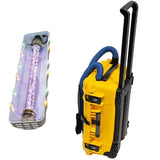How to Use UVC to Sanitize Car & Truck Interiors
Posted by Nick on for ProLampSales
With the rise of COVID-19, ultraviolet sanitation of air and surfaces has been increasingly used in applications outside of medical settings.
Several airlines are now using UVC lights to kill germs that may be on airplane electronics panels, as well as in the plane's HVAC system.
There have also been a wide range of low-output UVC devices marketed to disinfect small spaces, including bathrooms and personal car and commercial truck interiors.
However, there are several challenges with using ultraviolet germicidal irradiation to disinfect vehicle interiors. Simply buying a small UVC device may not be nearly enough to sanitize a car interior or the cab of a semi-truck.
Can UVC Disinfect Car & Truck Interiors?
The first question is whether UVC is effective at all in disinfecting the inside of cars and trucks. Thankfully, this is easy to answer.
UVC light would face no extra barriers to deactivating harmful pathogens in a vehicle, and no microbe has yet been discovered that is immune to ultraviolet irradiation.
So UVC devices can be used in vehicles to disinfect the air and surfaces. But these areas can present unique challenges.
Challenges with Using UVC in Vehicle Interiors
Fabrics
For sterilizing N95 masks, the CDC recommends a UV dose of 1,000 mJ/cm2, which is a very large dose of ultraviolet light. It's far more than the UV dose required to deactivate 99.999% of SARS-CoV-2, the virus that causes COVID-19, and far more than required to deactivate MRSA, C.diff, and other pathogens.
The CDC recommends this large amount of UVC because of the nature of N95 masks, which are made of fabric that has textures and shadows that UVC may not penetrate effectively or will provide areas for microbes to hide in shadows.
Almost all fabric interiors of cars and trucks will face this same issue. Seats and cushions made of leather will not have the problem to the same degree as those with fabric, but fabrics will require larger doses of UV due to limited penetration of the light.
Shaded Areas
Using one UVC device in the middle of the vehicle interior can create large areas that will receive no coverage. Seats, the steering wheel, center console, and other objects can create shadows where the light does not reach.
Areas that receive no UVC light will have negligible UV sanitation.
Vehicle Central Heating & Cooling
For residential homes and commercial buildings, UVC HVAC systems make a ton of sense and may be the most effective use of UVC. They continuously purify air as it circulates in the ducts, working in conjunction with filters to remove large particles and deactivating smaller pathogens.
In a personal or commercial vehicle, there is little room to install a UVC HVAC system, and we have not seen any commercially available kits. This means that the air inside an automobile should only be sanitized with UVC in between trips.
So for vehicles in operation, there are very few options using UVC, and long-term far-UV has not yet been proven safe for all types of human skin and eyes.
Best Practices
Wipe Surfaces Down First
UVC is most effective when used with other sanitation practices. Wiping down surfaces with a cleaning solution can remove large particles and kill a wide range of germs. This can also help aerosolize smaller particles, making them easier for UVC to act on.
Evenly Space Multiple UVC Units
Because there may be multiple areas of shade, no matter which UVC devices are placed in the vehicle, it may make more sense to use multiple devices rather than increase the power of just one fixture.
This can also keep UVC devices closer to seats and cushions that may require large UV doses.
Choose Units with Enough Power
Due to some of the above reasons, smaller UVC devices may not be effective since pathogens hiding in fabric can require large doses of UV.
We've seen some UV disinfection devices marketed for cars that use the same tiny UVC light bulbs as toothbrush sanitizers. With the larger space and complex fabric used in vehicle interiors, this is not enough power to disinfect in a timely manner.
And if you're going to invest in a UV germicidal device, you might as well get units powerful enough for effective disinfection of the areas to be treated.
Handhelds for Trouble Areas
Finally, for areas that are very difficult to reach with a stationary UVC device, handheld units can be used. This might be under seats, in the glove box, and in other areas where UVC light would not normally reach with the devices.
Because of the large area in a car or truck, and the time required for UVC to be effective, handheld ultraviolet devices don't make a lot of sense as a first option, but they can be a good supplement.
Testing UV Dose on Vehicle Interior Surfaces
No matter what UV bulbs or fixtures are used, it would be important to verify the unit was on long enough to reach certain levels of ultraviolet dose.
UVC dosimeters are the most common measurement and verification device, and are relatively low cost.
For flatter surfaces with a smooth texture, 25/50/100mJ dosimeters could be used to ensure UVC dose is applied to cross thresholds to inactivate SARS-CoV-2, MRSA, C.diff, and other pathogens.
For more complex surfaces with fabric, the dosimeters that measure 500-1,000mJ would make more sense. These surfaces may need the larger dose because of all the small areas of shadow the fabric can create.
- Posted in Automotive, Ultraviolet Light
Featured Products (View All)
0 Comments


